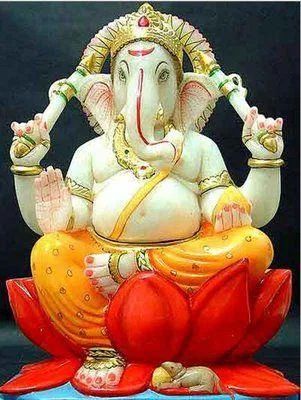
Ganesha or Ganapathi, undoubtedly, is the most popular among the Hindu gods. His popularity and worship extends also to Buddhism and Jainism. He is worshiped not merely in India but in other parts of the world too. He is an ancient god. His origins are not certain. It is also not certain when the Ganesha worship began.
1. Vedic origin
1.1. The earliest reference to Ganapathi appears in the second book of the Rig Veda in the rik starting with Gananam tva Ganapati Gum Havamahe (RV 2.23.1). The Ganapathi invoked here, is the Chief of the Ganas, the leader of the group, a superb seer among seers, and the lord of the mantras. It is explained that Ganapathi in this rik refers to Brahmanaspati, a Vedic divinity of the highest order, the leader of the heavenly bands and a sage (kavi) among sages (Jyeshta Rajam Brahmanam, Brahmanaspata).
Gaṇānāṃ tvā gaṇapatiṃ havāmahe kaviṃ kavīnām upamaśravastamam | jyeṣṭharājam brahmaṇām brahmaṇas pata ā naḥ śṛṇvann ūtibhiḥ sīda sādanam ||RV_2,023.01||
1.2. In the Rig Veda, Brahmanaspati is the lord of all sacred prayers and lord of Satya mantra. He is the destroyer of enemies; and no sacrifice is complete without invoking him. Brahnanaspati was a partner with Brahma in creation. Brahmaņaspathi was also the middle term that once linked the Vedic Brahma and Brihaspathi’. They are the names “of a deity in whom the action of the worshipper upon the gods is personified”.
1.3. Brihaspathi is the personification of piety, purity and knowledge. He is called `the father of the gods,’ and a widely extended creative power is ascribed to him. He is also `the shining’, `the gold-colored,’ and `having the thunder for his voice.” Other epithets of Brihaspati are Jiva – the living, Didivis – the bright, Dhishana – the intelligent, and for his eloquence, Gishpati– the lord of speech.
There are over one hundred riks in praise of these two deities, giving a picture of their powers and personalities.
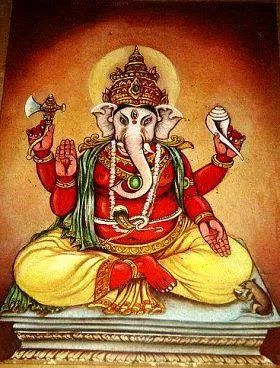
1.4. The Gaņapathi in Rig-Veda is the lord of gaņas or hosts. In the Rig-Veda, the gaņās or hosts of Bŗihaspathi—Brahmaņaspathi are the chants, the riks and the stomas, the words of praise (RV. 4.50.5). They have little to do with the lower vital levels.
sa suṣṭubhā sa ṛkvatā gaṇena valaṃ ruroja phaligaṃ raveṇa | bṛhaspatir usriyā havyasūdaḥ kanikradad vāvaśatīr ud ājat ||RV_4,050.05 ||
1.5. The term Gana also denotes a host of angles (Devas). Indra is referred to as Ganapathi in the tenth book of the Rig Veda (RV. 10.112.9); Indra is the Lord of the companies (Maruts).
ni ṣu sīda gaṇapate gaṇeṣu tvām āhur vipratamaṃ kavīnām | na ṛte tvat kriyate kiṃ canāre mahām arkam maghavañ citram arca ||RV_10,112.09||
1.6. The mantra ‘namo Ganebhyo ganapathibyasha vo namo’ (16-25) that occurs in Shukla Yajurveda samhita refers to ganas, in plural, and says: salutations to you, Ganas and to the Lord of the Ganas. This mantra appears also in the Rudra prasnam (4.1.5) and in the Maitrayani-Samhita (2,9.4). Gana in these contexts signifies a group of people as also a collection of mantras.
namo gaṇebhyo gaṇapatibhyaś ca vo namo namo vrātebhyo vrātapatibhyaś ca vo namo namaḥ kṛchrebhyaḥ kṛchrapatibhyaś ca vo namo namo virūpebhyo viśvarūpebhyaś ca vo namo namaḥ senābhyaḥ senānībhyaś ca vo namo namo rathibhyo varūthibhyaś ca vo namo namaḥ kṣattṛbhyaḥ saṃgrahītṛbhyaś ca vo namo namo bṛhadbhyo ‘rbhakebhyaś ca vo namo namo yuvabhya āśīnebhyaś ca vo namo namaḥ //MS_2,9.4//
1.7. The Taittiriya samhita interprets Ganas as pashus (the beasts of Shiva). They are the Ganas of Shiva — Rudrasya Ganapathyam .There were also Bhuta ganas, the weird and grotesque looking guards of Shiva. Thus, Shiva the Pashupathi; and Shiva the Bhoothnath was also a Ganapathi.
1.8. At a much later period, when the Puranas came to be compiled, the virtues and powers of all the Ganapathis of the past were transferred to the Ganapathi as we are familiar with; that is to our Ganapathi. He became the Lord of Ganas in every sense of the term. Not only that, he became much larger than the sum of the parts.
1.9. It is not significant what shades of meanings the term carried in the past; but it is very important for us that our Ganapathi, the Lord of Ganas, whom we worship with love and adoration, is the embodiment of all the grace, virtues and powers that we admire in any god. He is the inheritor of the combined wisdom and glory of all the gods; and is much more than the sum. He is Maha Ganapathi. That is what really matters.
2. Elephant god

2.1. It is not certain how the Ganapathi-elephant association came into being. The earliest reference in that regard is in the Atharva Veda which alludes elephantine countenance (hasthi –varchas) to the Vedic god Brihaspati who was one of the forerunners of our Ganapathi. Our Ganapathi seems to have inherited his features from the descriptions of Brihaspati.
2.2. The other early references are in Maitrayani samhita (2.9.1) and Taittiriya Aranyaka (10.1.5) which appeal to an elephant faced (hasthi-mukha) , single-tusked (dantin) deity with a curved trunk (vakra tunda).He is also described as holding a corn-sheaf, a sugarcane and a club. Those features became the characteristics of our Ganapathi, the Ganesha.
tat karāṭāya vidmahe hastimukhāya dhīmahi / tan no dantī pracodayāt //MS.2.91//

2.3. Amarakosha the Sanskrit lexicon (say 4th century AD), lists eight synonyms of Ganesha : Vinayaka, Vighnaraja, Dvai-matura (one who has two mothers), Gaṇadhipa (equivalent to Ganapati and Ganesha), Ekadanta (one who has one tusk), Heramba, Lambodara (one who has a pot belly, or, literally, one who has a hanging belly), and Gajanana having the face of an elephant). It seems by then the Ganapathi and his half- elephant form were quite well established.
vināyako vighnarāja dvaimātura gaṇādhipāḥ / apy ekadanta heramba lambodara gajānanāḥ ( 1.1.93 -94)
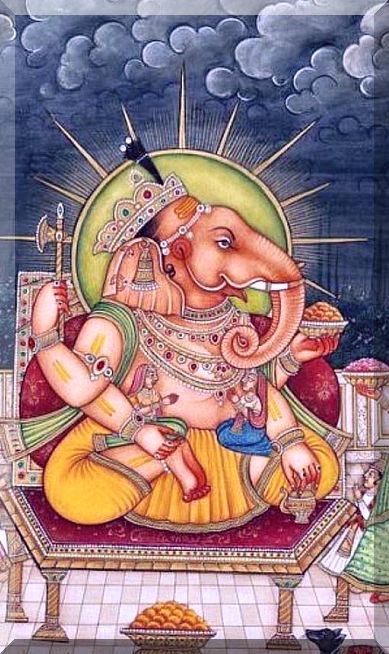
2.4. Vishnudharmottara, a text dated around 5-6th century, while detailing how to make images of various deities, describes, among others, how the image of Vinayaka should be made (Part Three; Ch 71; verses 13-16). Sage Markandeya explains:
Vinayaka should have the face of an elephant and four hands .He should have a big belly; stiff pair of ears; wearing a tiger skin around his waist and a sacred-thread across his left shoulder down his belly. He should have snake as belt. a trident and rosary should be placed in right hands; an axe and a pot full of sweets in the left ones. The sweet-pot should be placed near the tip of his trunk. His left tusk should be left un-represented. Vinayaka should be provided a foot-stool; and his one foot should be placed on it.
- Vinayakasthu kartayo Gaja-vakthra-Chatur-bhujaha / Shukalam cha Aksha-malam cha tasya Dakshina-hasthayoh //13//
- Paathram Modaka-purnam tu Parashu chaiva Vamataha / Dantascha-sya na karthavyo Vamo , Ripu-nishodana //14//
- Paada-pitai krutaha Paadaha Eka Asanago bhaveth / Purna-Modaka-patram tu karagre tasya karayeth //15//
- Lambodaras-tattha karyaha Sthabdha-karnascha-yadava /Vyagra-charmam-bhara-dharaha Sarpa-yajnopavithiman //16//

2.5. Before I end this segment let me add, the Tamil language, one of the oldest languages in the world, fondly addresses Ganapathi as Pille or Pilleyar, meaning the little darling or a small child. Some scholars say that term pille also meant, in old Tamil, a young elephant. Incidentally, the Pali word pillaka also means a young elephant. The association of a sweet looking child with the innocent countenance of a young elephant could also have had its origins in tribal lore.

3. Destroyer of obstacles

3.1. Brahmanaspati of the Rig Veda was the divine being who led the aspirant along the path of wisdom and facilitated his progress by removing the obstacles in his path. It is said, this aspect of Brahmanaspati was later expanded in to the role of Ganapathi as Vinayaka, the destroyer of obstacles. But Ganapathi is also the lord of obstacles (Vighnaraja).But, why would a benevolent god cause obstacles? It is explained that Ganapathi does not cause obstacles but controls obstacles. It is therefore prudent to pray to him before launching on any venture – big or small.

3.2. He intercedes with gods on behalf of humankind and protects them from the wicked influences.
Thus, Ganapathi as the destroyer of obstacles had taken root by about first century AD.
4. God of learning and wisdom
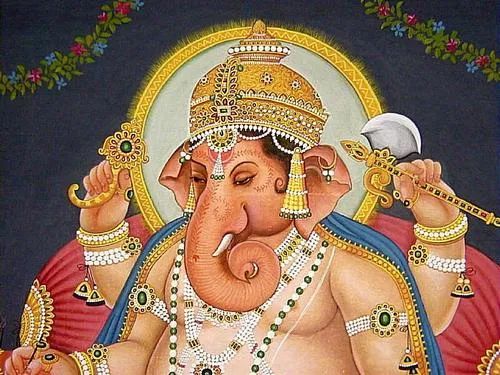
4.1. Ganapathi is also associated with mental agility and learning. He is akin to Brihaspathi of Rig Veda, the personification of piety, purity and knowledge. He is known for his intelligence, and for his eloquence. He is Gispati – the lord of speech- bṛhaspatiḥ surācāryo gīṣpati rdhiṣaṇo guruḥ (1.3.223)
4.2. Siddham was in the distant past one of the names given to the collection of Sanskrit alphabets. Patanjali explained the term as “that which is established” (pūrvatrāsiddham). The beginners would commence their learning of the alphabets with the chant: ”Om namo Siddham”. Even the scribes of the epigraphs would etch an inscription starting with the words “siddham or Swasthi”. Since Ganapathi evolved also into the god of wisdom and learning the terms Siddham and Swasthi too came to be associated with him.
4.3 Ganapathi is the patron god of wisdom and all branches of learning; not merely spiritual or of art or music or literature but of all human endeavours.
5. Ganapathi worship

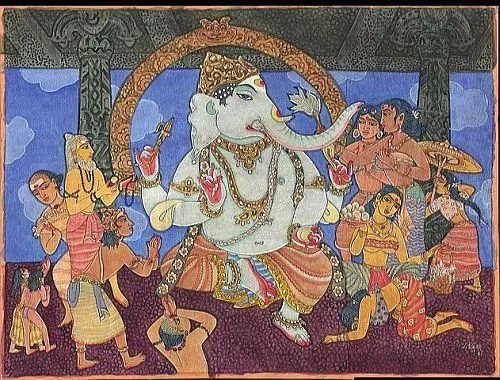
5.1. I reckon the Ganapathi worship has a history of about two thousand years. The ancient Grihya sutras and Dharma sutras do not mention about praying to Ganapathi at the commencement of a worship-ritual. Natyasastra, dated around second century BCE, too, does not refer to Ganapathi.
5.2. Perhaps the first reference to Ganapathi worship occurs in the Gobhila Grhya Sutra, which belongs Sama Veda. It recommends praying to Ganapathi and to Matrikas at the commencement of a ritual, seeking blessings and support for a smooth and successful completion of the ritual process. Gobhila Grhya Sutra is dated around first century AD. From then Ganapathi has carried on famously.


5.3. Baudhayana Grihya Sutra which described Ganapathi as Vigneshwara, Bhootha-natha and Gajamukha, too recommended similar worship of Ganapathi. It also prescribed offering apupa and Modakas to propitiate him. The date of this text is disputed; it could perhaps be around the same time as the other Sutras.
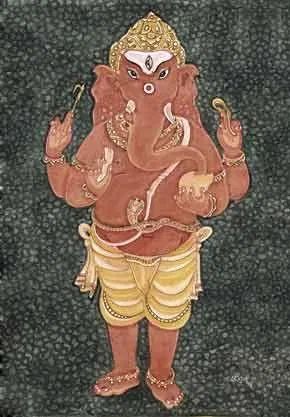
5.4. Another text of first century, Gatha-saptha-shati, sings the praise of Ganadhipathi. The Puranas, which came about around that period too carry detailed references to Ganapathi and to his worship (e.g. Varaha Purana, Vamana Purana and Brahmaiva-vartha purana).
5.6. The Yajnavalkya Smriti (dated around third century AD) mentions Vinayaka as the Lord of the Ganas, appointed by Brahmna and Rudra. Here he is described as one who causes obstacles as well as one who removes them. Yajnavalkya gives four names of Vinayaka the son of Ambika as: Mita, Sammita, Salakantaka and Kusumandarjaputra .Vinayaka here is worshiped as a Tantric deity.
6. Emergence of Ganesha
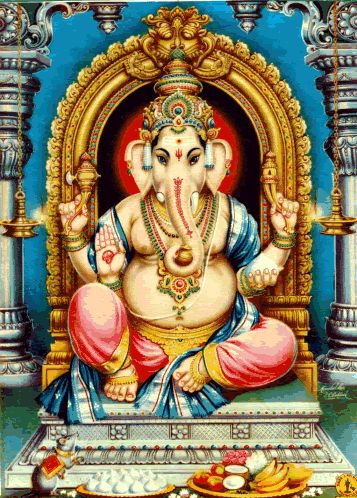
6.1. Ganesha appeared in his classic form as a clearly-recognizable deity with well-defined iconographic attributes in the early 4th to 5th centuries. Ganesha images thereafter became prevalent in all parts of India and in many parts of the world.
6.2. Ganesha emerged as a distinct deity in clearly recognizable form in the fourth and the fifth centuries during the Gupta period. His popularity rose quickly. The son of Shiva and Parvati; Ganesha with an elephantine countenance, a curved trunk, pair of big ears and a pot-bellied body of a human is now the Lord of success; and destroyer of evils and obstacles. He is the god of education, knowledge, wisdom and wealth. Ganesha also became one of the five prime Hindu deities (Surya, Vishnu, Shiva and Durga being the other four) worshiped in the panchayatana puja. A new tradition called Ganapathya thereafter came into existence.




Perhaps no other god , either in Hindu or any other religion, been depicted in as many varieties of forms as Ganesha has been. He has been depicted in every conceivable form.
 6.3. With the spread of Indian trade to the Far- East, by around the tenth century, Ganesha a favorite with the traders and merchants reached the shores of Bali, Java, Cambodia, Malaya, Thailand, Vietnam and other islands. In Indo-china, where Hinduism and Buddhism were practiced side by side and influenced each other, Ganesha was the God acceptable and dear to all. Even to today, the people in Burma, Vietnam, Cambodia and Thailand worship Ganesha as the destroyer of obstacles and as the god of success.
6.3. With the spread of Indian trade to the Far- East, by around the tenth century, Ganesha a favorite with the traders and merchants reached the shores of Bali, Java, Cambodia, Malaya, Thailand, Vietnam and other islands. In Indo-china, where Hinduism and Buddhism were practiced side by side and influenced each other, Ganesha was the God acceptable and dear to all. Even to today, the people in Burma, Vietnam, Cambodia and Thailand worship Ganesha as the destroyer of obstacles and as the god of success.
**
According to Wikepedia
In Thailand, Ganesha is called Phra Phikanet or Phra Phikanesuan and is worshiped as the deity of fortune and success, and the remover of obstacles. He is associated with arts, education and trade. Ganesha appears in the emblem of the Department of Fine Arts in Thailand. As lord of business and diplomacy, he sits on a high pedestal outside Bangkok’s Central World (formerly World Trade Center), where people offer flowers, incense and a reverential sawasdee Thai Cuisine.
With regards to Indonesia, Ganesha is called the ‘Indonesian God of Wisdom’. Bandung boasts a Ganesha Street. A Ganesha statue from the 1st century AD was found on the summit of Mount Raksa in Panaitan Island, the Ujung Kulon National Park, West Java. While there are not temples dedicated specifically to Ganesha, he is found in every Shiva shrine throughout the islands. An 11th-century CE Ganesha statue was found in eastern Java, Kediri is placed in The Museum of Indian Art (Museum fur Indische Kunst), Berlin-Dahlem. The 9th century statue of Ganesha resides in western cella (room) of Prambanan Hindu temple.

Ganesha statue at Sanggar Agung Temple, Surabaya-Indonesia, worshiped by the Chinese, Hindus, Buddhist and even the Kejawen
As regards Thailand, William Jones and Ruchi Agarwal write in ‘ Ganesa and his cult in contemporary Thailand’

**


Bhutan Ganesha Tibet Ganesha


Sakya Ganesha Tibet Tantric Ganesha Tibet
6.4. Ganesha appears in Jainism too. A fifteenth century Jain text provides procedures for the installation of Ganapathi images. Images of Ganesha appear in the Jain temples of Rajasthan and Gujarat; the earliest of which is dated around eighth century.

7.5. In Buddhism, Ganesha appears not only in the form of the Buddhist god Vināyaka, but also as a Hindu demon form with the same name (Vināyaka). As the Buddhist god Vināyaka, he is the dancing Nritta Ganapathi. Worship of Ganesha is popular also in Tibet.


Buddhist Ganeshas of Mangolia
According to another version, Ganesha as siddhidata (bestower of success) is Buddha himself revealing Ganesha’s powers to his disciple.
7.6. Ganesha traveled to other countries along with Buddhism. In northern China, the earliest known stone statue carries an inscription dated to 531AD.In Japan the Ganesha cult was first mentioned in 806 AD; and is still flourishing. Here, Buddha and ganesha are worshiped together.

[Scholars say, artifacts from excavations in Luristan and Harappa and an old Indo-Greek coin from Hermaeus, present images that remarkably resemble Ganesha”. (“Robert Brown in his Book “Ganesha: Studies of an Asian God”: State University of New York Albany).]
8. Whatever might have been his origins, The Ganapathi -Ganesha that we know and adore represents the combination and culmination of the virtues and powers of all the Ganapathis that preceded him. He is the sum and substance of all the preceding Ganapathis .He is the embodiment of all their grace and wisdom .He is adored by one and all; by all segments of the society and of all ages.


Children, particularly, love Ganesha as a playful mate and as the best friend. The little Ganesha is a darling.
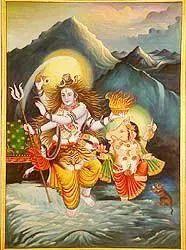





Amazing Facts of Ganesha
 There are 250 temples of Ganesha in Japan.
There are 250 temples of Ganesha in Japan.
In Japan, Ganesha is known as ‘Kangiten’, the God of fortune and the harbinger of happiness, prosperity and good. Young Japanese worship Ganesha to win in love whereas the old worship the deity to get success in business.
East India Company issued a Ganesha coin in 1839
The British East India Company in 1839 issued a copper ½ Anna coin measuring 32mm with reeded edge and weighing 12.81 grams. The coin carried the Ganesha image on the obverse.


Another bronze coin weighing 3.4 grams and measuring 16.4 x 15.5mm; the obverse depicts Ganesha seated facing, while the reverse has a lattice design that is rather common to certain areas of India. But, I am unable to say to which state or era the coin belongs.
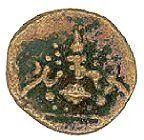
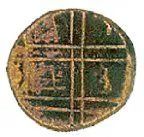
Kurundwad –court Fee stamp with Ganesha motif .
Kurundwad (Senior Branch) in Kolhapur District the erstwhile British Bombay Presidency issued a Court Fee paper of Rupees Forty featuring Ganesha at its centre.
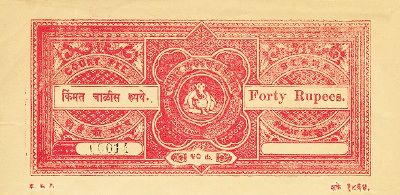
Indonesia Currency notes
One of the Indonesian currency notes carries the picture of Ganesha.
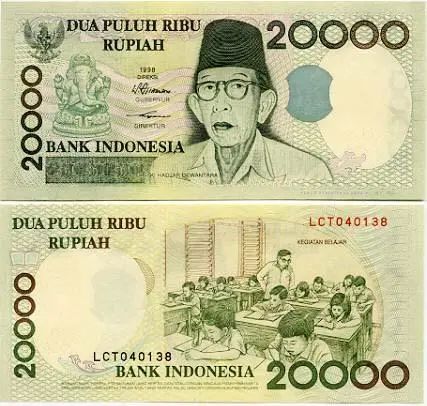
Silicon Valley in USA selects Ganesha as the presiding Deity of cyberspace technology
“Ganesha is the God of knowledge and Ganesha’s vehicle is the mouse .Hence the computer industry association selected Ganesha as the presiding Deity of Silicon Valley.

References:
Ganesha : http://en.wikipedia.org/wiki/Ganesha
Historical development of Ganesha: http://en.wikipedia.org/wiki/Historical_development_of_Ganesha
Posted by Colin : Ganesha, Hinduism€™s favorite representation of God
Origins of worship of Ganesha http://www.hindunet.com/forum/showflat.php?Cat=15,44&Number=4892&Main=4892


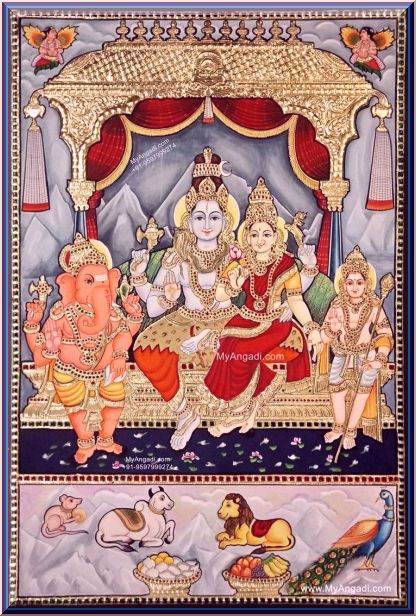
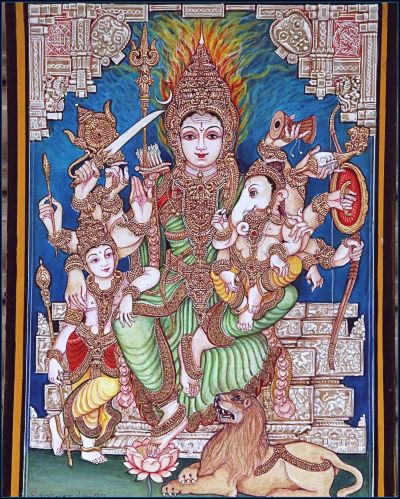
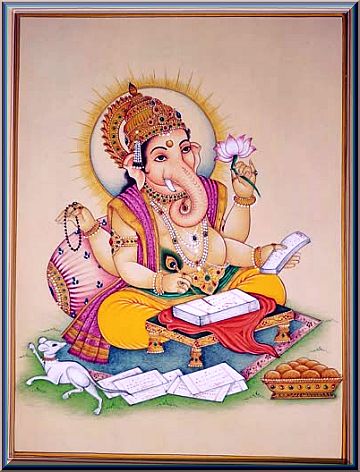
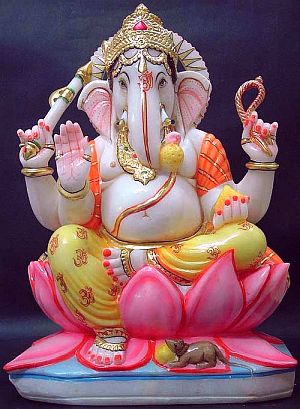
Saddha
November 27, 2013 at 1:07 am
You mention Siddham Sanskrit. Siddham Sanskrit is the language and alphabet of Mahayana Buddhism. You can do a search and you will see the Siddham alphabets compared to the Devanagari.
sreenivasaraos
November 27, 2013 at 2:40 am
Thank you, Saddha, for the comment. Yes; the Siddham script is a descendent of the Brahmi script and an ancestor of the Devanagari script. The script is a refinement of the script used during the pre- Gupta Era. It could even be called the older form of Sanskrit script as we know it today. The name Siddham comes from Sanskrit; and it means ‘accomplished or perfected’. There came into practice the writing the word Siddhaṃ, or Siddhaṃ astu (may there be perfection) at the head of documents.
In India, Siddham was replaced by Devanagari script. But, Siddham has survived in East and Far East mainly because it was the earliest vehicle for spread of Buddhism in those areas. In the early years ( say up to the ninth century) when Chinese scholars travelled to India for studies in Buddhism, they would invariably take back with them the copies of the old Buddhist manuscripts in Siddham script. And, when it came to translating those texts to Chinese they considered it important to preserve the purity of the pronunciations of the mantras. But, since the Chinese was not suitable for writing the sounds of Sanskrit, the scholars of those days thought it fit to retain the Siddham script. This led to the practice of using Siddham while copying Buddhist texts in China, Japan and Korea. An adaptation of the script is still used in Japan, where it is called Bonji. It is used for copying the Mantras and Sutras. In China, the series of cultural purges put an end use of Siddham script. But, it survives somehow in East and Far East Asia where Buddhism particularly the Tantric Buddhism is still alive.
Regards
Web
January 3, 2014 at 1:12 pm
I love your blog.. very nice colors & theme. Did you make this website yourself
or did you hire someone to do it for you? Plz answer back
as I’m looking to design my own blog and would like to find out where u got this
from. appreciate it
sreenivasaraos
January 3, 2014 at 2:49 pm
Dear Web, You are welcome.
The content (text and pictures ) are mine.
The page – itself – by WordPress
WordPress.com. Customized Choco Theme.
Wish you a Happy New Year
Regards
Narayan
March 12, 2014 at 5:43 pm
Dear SreenivasRao, Please quote me the manthra from upanishads, that you stated as “Taittariya Aranyaka (10.1.5) which appeal to an elephant faced (hasthi-mukha) , single-tusked (dantin) deity with a curved trunk (vakra tunda)”.
This kind of god is not truth and is only a creation of human mind in later periods of puranas.
Vedas nor Upanishads describe Ganesha having such elephant face, riding on a rat, having lambodaram.
sreenivasaraos
March 13, 2014 at 3:13 am
Dear Ramnarayan
In Krishna-Yajurveda – Taittriya Aranyaka (the Tenth Prapata of which is also called Mahanarayana Upanishad) we find the words: Karaata ( having the cheek of an elephant ; having a trunk ) ;hasti-mukha ( having an elephant face ) ; Vakra-tunda ( on with a twisted tusk) ; and , Dantin (having a single tusk)
Tat karaataya vidmahe, hastimukhaya dhimahi, tan no dantih prochodayat I
Tat Purushaya vidmahe , vakratundaya dhimahi , tan no dantih prochodayat I
A similar Gayatri appears in Maitrayani Samhita of the Krishna Yajurveda. The Great Vedic scholar Sri Sayana-acharya in his commentary on Taittiriya Aranyaka identifies identifies this deity with Ganesha .
Regards
sreenivasaraos
March 13, 2014 at 4:11 am
Tantric representation of Ganesha in the form of five basic elements (maha-bhutas)
Ganesha is conceived as an embodiment of all elements . The earth – the gross element – is represented by a rectangle forming the base on which Ganesha is seated. Water is represented by his round belly; fire by a triangle: his tusk , mouth and upper trunk ; the air by a crescent ( his third eye) ; and , the space by a flame ( his true self).
[ O Lord Ganapathi , the whole world is sprung from you. This whole world rests in you. This whole world is coming to you . You are the Earth, Water, Fire , Air and Space.]
Further , in Tantric worship , Earth is represented and controlled by Shiva; the Water by Ganesha; the Fire by Shakthi ; the Air by Surya; and , the Space by Vishnu.
sreenivasaraos
March 20, 2015 at 10:43 am
dear sreenivasarao,
the ganapathyam of
nilakanta shastry talks of the meaning of myth of
ganesha…
it is the way a strong mother influenced communities have their integration with the enrgy of father by having their rationality replaced with the intervention of the
father…the ardanareeswara concept of male and female integration and also the purusha prkriti integration which leads to an adavitic unity is represented in this form…
i heard it from my father… the writing of my great grand father neelakanta shastry is lost alas..
though the essense remained in our understanding….
thanks for this wonderful blog. the information in brahaspati i sinteresting…as numerologically
brahaspati represents 3(a unified identity of the male(1) and femle(2)
whereas ganapthi is represented by 21… the same three but in a way female imtegrated by male intervention…
DSampath
sreenivasaraos
March 20, 2015 at 10:44 am
dear shri sampath,
thank for your illuminating comments.
i was vaguely aware of the significance of 21 associated with ganesha; but it didn’t strike me to mention that (in my post on ardhanari too). i didn’t know about association of 3 with brihaspathi. thanks for mentioning.
regarding ganapathyam, in the first instance i mentioned it as a phrase to indicate shiva’s hordes rudrasya ganapathyam. i again made a reference to ganapathyam as a doctrine that developed by about 7-8th century. i understand that ganapathyam venerates ganesha as the ultimate reality. but, i am not quite conversant with its principles and practices. what you said about mother-influence to en- charge and hold the community together is very interesting.
coming back to ardhanari – ganesha, did you check the picture of ganesha in ardhanari’s arms? it is picture of around 16th century.
you occasionally refer to your ancestors, who were men of great learning. you could , at sometime, consider writing about them, briefly. that would be great.
thank you for the detailed comments.
wish you a happy ganesh.
regards
sreenivasaraos
March 20, 2015 at 10:46 am
Your writing on Ganesha is very interesting, especially how other countries have used this icon. I thought of sharing an insight I had after a session on Kriya practices with the son of Lahiri Mahasaya of Kasi. Many exercises were to raise and lower the kundalini shakthi along the spinal chakras. One was different. The energy had to be raised up to the forehead chakra, then perform a chin lock as in yogasana, and project the energy to the navel chakra and keep it tied there. The reverse process was done thereafter. Imagine a person who has practised it assiduously for long. What would his aura shape be? He would surely have an expansive face with the energy flowing down to his navel like the elephant trunk. These energy chanels help in the attainment of certain powers of concentration and siddhis.(Remove obstacles and be master?) Likewise the enlarged ear chakras may be the result of certain types of meditation and kriyas. This may be the real tantric vision of Ganesha. and the fascinating truth may be that if you practise these things you may attain the likeness of Ganesha. Are we not made in his image in more ways than one?
Padma Raghavan
sreenivasaraos
March 20, 2015 at 10:46 am
Dear raghavan, Wow..! That was very interesting; and you are truly remarkable. You have gone deep into many things. Yes, there is a close relation between Yoga and Tantra; and Ganapathi figures prominently in both the streams of Sadhana. Ganapathi is regarded the synthesis of all the five elements. The earth element is represented by a square; the water by circle; fire by triangle; air by half-moon; and space by Bindu (point). It is said all these features can be found in the form of Ganapathi. Further, if his tusk is Om-kara; his belly the great space; the serpent around his belly the Kundalini enclosing all; his rat the Rajo-guna; which Ganapathi controls riding on it.
Yes, as you said , we are made in his image.
Thank you for an insightful comment.
Regards
sreenivasaraos
March 20, 2015 at 10:48 am
I was trying to figure out how all the shapes , square, circle etc. can be found in Ganesha. In a stylized depiction perhaps. Any help on this?
Padma Raghavan
sreenivasaraos
March 20, 2015 at 10:48 am
Dear Padma Raghavan,I think I should have explained, Sorry, in Tantra the Yantra of a divinity is represented both in iconographic and geometric forms. The one represents the other. Regards
sreenivasaraos
March 20, 2015 at 10:53 am
In Krishna-Yajurveda – Taittriya Aranyaka (the Tenth Prapata of which is also called Mahanarayana Upanishad) we find the words: Karaata ( having the cheek of an elephant ; having a trunk ) ;hasti-mukha ( having an elephant face ) ; Vakra-tunda ( on with a twisted tusk) ; and , Dantin (having a single tusk)
Tat karaataya vidmahe, hastimukhaya dhimahi, tan no dantih prochodayat I
Tat Purushaya vidmahe , vakratundaya dhimahi , tan no dantih prochodayat I
A similar Gayatri appears in Maitrayani Samhita of the Krishna Yajurveda. The Great Vedic scholar Sri Sayana-acharya in his commentary on Taittiriya Aranyaka identifies identifies this deity with Ganesha
***
Ganesha is conceived as an embodiment of all elements . The earth – the gross element – is represented by a rectangle forming the base on which Ganesha is seated. Water is represented by his round belly; fire by a triangle: his tusk , mouth and upper trunk ; the air by a crescent ( his third eye) ; and , the space by a flame ( his true self).
[ O Lord Ganapathi , the whole world is sprung from you. This whole world rests in you. This whole world is coming to you . You are the Earth, Water, Fire , Air and Space.]
Further , in Tantric worship , Earth is represented and controlled by Shiva; the Water by Ganesha; the Fire by Shakthi ; the Air by Surya; and , the Space by Vishnu.
.
sreenivasaraos
March 20, 2015 at 10:49 am
So wonderfully researched, Srinivas Rao…thank you for giving me such a lovely insight into my favorite deity!
Regards,
Srinath Girish
sreenivasaraos
March 20, 2015 at 10:50 am
I would like to correct the explanation for the tamil term-PILLAIYAR.
It doesn’t mean little darling. It means “Whose son is this”
PILLAI-SON
YAR-WHO
The first meeting of Shiva and Ganapati was at warfront, with Ganapati trying to prevent shiva’s entry into his house as per his mother’s instruction. After his head is scooped off, parvati comes running out and sheds motherly tears.
So shiva asks her- PILLYAI YAR? Who is this child…
Parvati is taken aback at this question and says- He is my son!
Everything is at a standstill for a moment and pillaiyar becomes pillaiyar’s name.
My understanding of this story is that when the husband is away, it is natural for a woman to feel lonely and beget a child(sometimes). And no matter whow the child is born, the husband ought to accept it as his son too.
That is how I summarize “PILLAIYAR”. Of course, traditionalists would find it unacceptable.
I always thought Hinduism gave enough respect for inevitable natural instincts.
Scribblingpad
sreenivasaraos
March 20, 2015 at 10:51 am
Thank you, Saddha, for the comment. Yes; the Siddham script is a descendent of the Brahmi script and an ancestor of the Devanagari script. The script is a refinement of the script used during the pre- Gupta Era. It could even be called the older form of Sanskrit script as we know it today. The name Siddham comes from Sanskrit; and it means ‘accomplished or perfected’. There came into practice the writing the word Siddhaṃ, or Siddhaṃ astu (may there be perfection) at the head of documents.
In India, Siddham was replaced by Devanagari script. But, Siddham has survived in East and Far East mainly because it was the earliest vehicle for spread of Buddhism in those areas. In the early years ( say up to the ninth century) when Chinese scholars travelled to India for studies in Buddhism, they would invariably take back with them the copies of the old Buddhist manuscripts in Siddham script. And, when it came to translating those texts to Chinese they considered it important to preserve the purity of the pronunciations of the mantras. But, since the Chinese was not suitable for writing the sounds of Sanskrit, the scholars of those days thought it fit to retain the Siddham script. This led to the practice of using Siddham while copying Buddhist texts in China, Japan and Korea. An adaptation of the script is still used in Japan, where it is called Bonji. It is used for copying the Mantras and Sutras. In China, the series of cultural purges put an end use of Siddham script. But, it survives somehow in East and Far East Asia where Buddhism particularly the Tantric Buddhism is still alive.
Please also check http://en.wikipedia.org/wiki/Siddha%E1%B9%83_alphabet
for Siddham alphabets.
Regards
sreenivasaraos
March 20, 2015 at 10:53 am
Dear Ramnarayan
In Krishna-Yajurveda – Taittriya Aranyaka (the Tenth Prapata of which is also called Mahanarayana Upanishad) we find the words: Karaata ( having the cheek of an elephant ; having a trunk ) ;hasti-mukha ( having an elephant face ) ; Vakra-tunda ( on with a twisted tusk) ; and , Dantin (having a single tusk)
Tat karaataya vidmahe, hastimukhaya dhimahi, tan no dantih prochodayat I
Tat Purushaya vidmahe , vakratundaya dhimahi , tan no dantih prochodayat I
A similar Gayatri appears in Maitrayani Samhita of the Krishna Yajurveda. The Great Vedic scholar Sri Sayana-acharya in his commentary on Taittiriya Aranyaka identifies identifies this deity with Ganesha
sreenivasaraos
May 15, 2017 at 4:59 am
Dear Shri Sitaraman
At the outset I beg your pardon for the delay in responding to your comment. Please excuse me. I was away; and, my health had also been rather inconsistent.
I presume you have read my articles regarding the Origins of Ganesha Worship ; and , Ganapathi, the lord of the ganas . These cover a number of issues that might interest you.
Ganesha, as we know and worship, does not, of course, figure in the early Vedic texts (Samhita). The Natyashastra (dated around second century BCE) begins with salutations to Pitamaha (Brahma) and to Maheshwara; and, the gods worshipped therein are basically the Vedic deities, such as: Sakra (Indra), Varuna, Vayu, Kubers, Surya, Vishnu and Sarasvathi. There is, however, no mention of Ganesha /Ganapathi.
From what little I have read, the scholars seem to think that the four or six Vinayaka-s mentioned in Mānava-Gṛhyasūtras and the Yajnavalkya Smriti were later rendered into a single Vinayaka; and , appointed by Rudra as the Chief of the Ganas – Gananam Adhipataye.
And, there was a deity named Dantin with an elephant – countenance (Hasthi –mukha) with a curved trunk (Vakratunda) In the Krisha Yajurveda (2.9.1163).
These varied forms , along with others, were brought together to combine into Lord Ganesha or Ganapathi. It is said; Ganesha emerged a distinct deity in clearly recognizable form in the 4th and 5th centuries CE, during the Gupta Era, combining in himself the features and virtues of the several of his Vedic and Pre-Vedic predecessors.
It was following this period, His popularity rose quickly; and, a separate Ganapthya sect which worshipped Ganapathi as the form of the Supreme Brahman came into being by about the Sixth century. Its faith and practices are described in Ganesha Purana, Mudgala Purana, Ganapathi Upanishad; and Ganesha Gita. The last mentioned, in a way, resembles Bhagavad-Gita; with Ganesha taking a position similar to that of Krishna. (Ganapathya, somehow, did not become a major sect as that of Shiva or Vishnu)
Ganesha Purana and Mudgala Purana are the primary scriptures of the Ganapathya –s. Both are described as Upa-Puranas. While Mudgala Purana describes eight incarnations of Ganesha, the other Purana, which perhaps is the later of the two, describes four of his incarnations.
According to the narration in Mudgala Purana, Gajanana was the fourth incarnation of the Lord Ganesha, to slay the demon of greed, Lobha.
And, again during the 8-9th century Ganapathi was formally included among the five principal deities (Panchayatana).
*
The prayer you cited “Gajaananam Bhootha Ganaadhi Sevitham” refers to Ganapathi as the darling son of Uma Devi; and as one who enjoys the essence (Sara) of kapitha (wood apple) and Jumbu (Rose apple) fruits, obviously relates to Ganapathi of the Puranas, which is after the 4-5th century.
I therefore, feel, that the prayer mentioned you could not possibly belong to the texts of the period from fifth century BCE to Second century BCE.
I am not sure if this meets your requirement.
Sorry for the delay
Regards
PS: I reckon that the Book Loving Ganesha might be interest to you. Please click here.
LilianaChief
March 25, 2018 at 10:21 pm
I have checked your page and i’ve found some duplicate content,
that’s why you don’t rank high in google’s search
results, but there is a tool that can help you to
create 100% unique content, search for: boorfe’s tips unlimited
content
sreenivasaraos
March 26, 2018 at 2:00 am
OK,Thanks
Please do tell me what exactly do you mean by ‘ duplicate content’.
Is it within the blog-content ; or is it in the Google-search ?
Cheeers
Sharon
May 9, 2018 at 7:07 am
Dear sir,
“om shreem hreem kleem glaum gam ganapataye
vara varada saravajanam me vashamaanaya swaahaa”
Is this Ganesha mula mantra ? Which scripture mentioned this manta ? If this is not correct ,please correct it.
sreenivasaraos
May 9, 2018 at 6:14 pm
Dear Sharon
Please refer to the following site for a discussion on the issue ”
https://hinduism.stackexchange.com/questions/19775/which-scripture-wrote-the-ganapathi-moola-mantra
Here, the Ganesha Mula mantra is mentioned as:
shrim hrim klim glaum gam ganapathaye
Vara-varadha sarva janam-mey vasamaanaya swaha
And the source is said to be
Narada Purana; and also Ganesha Vimarshini Tantram,; Brihat Srikrama Tantram; ViswasAra Tantram etc
Regards
Mark
January 23, 2019 at 9:34 am
Dear Sir, can I ask please a question about Ganesha that I have. He is mounted on a horse. I note you have a picture on this website. I can not find any information regards the use of a horse as his mount.
Any info would be much appreciated.
Regards,
Mark.
sreenivasaraos
January 23, 2019 at 5:46 pm
Dear Mark
Thanks for the visit ; and , for the comment.
Ganesha is , lovingly , depicted in countless varieties of ways
He is shown as riding varieties of animals and birds : rat; horse; elephant; lion ; peacock etc.
He is also shown riding a bicycle; motorcycle; car etc; or even flying an aircraft.
It is amazing
Cheers
AJ infotech
August 18, 2019 at 5:42 pm
I love my friendly lord ganesha,and in south side we celebrate this fest with family all to gather and we eat verity of dishes Like…https://ajinfotech1.blogspot.com/2019/08/ganesha-chathurthi-2019.html
sreenivasaraos
August 19, 2019 at 4:05 am
wow ..Good for you
Cheers
Aditya
December 21, 2022 at 10:23 pm
Dear Sreenivasaji, It is interesting that Ganesha doesn’t find mention in the two itihaasas. The Vaalmiki Raamayana talks about the birth of Karthikeya but there is no mention about Ganesha in the whole epic. Mahabharatha also is silent about Ganesha’s origin. The story about Ganesha writing Mahabharatha is also not found in all the rescensions. In the Bhagavad Gita, Krishna mentions about Skanda as the general of army. If Ganesha was considered all auspicious god, then he shouldn’t have been missed in mentioning
It seems that only around 4-5 century AD when Tantric Buddhism got mixed with Yoga philosophy then we see the birth of Ganesha and the associated legends. In Yoga he is considered as the ruler/controller of Muladhara and that’s why he is to worshipped first as from Muladhara itself the Kundalini rises.
sreenivasaraos
December 22, 2022 at 1:56 am
Dear Aditya
Yes Sir
Thanks for the observations.
As I mentioned; the Ganapathi as we know , love and revere emerged as an amalgam of the virtues and powers of several of the Vedic deities.
The ancient Grihya sutras and Dharma sutras do not mention about praying to Ganapathi at the commencement of a worship-ritual. Natyasastra, dated around second century BCE, too, does not refer to Ganapathi.
At a much later period, when the Puranas came to be compiled, the virtues and powers of all the Ganapathis of the past were transferred to the Ganapathi as we are familiar with; that is to our Ganapathi. He became the Lord of Ganas in every sense of the term. Not only that, he became much larger than the sum of the parts.
Ganesha emerged as a distinct deity in clearly recognizable form in the fourth and the fifth centuries during the Gupta period.
Ganesha appeared in his classic form as a clearly-recognizable deity with well-defined iconographic attributes in the early 4th to 5th centuries. Ganesha images thereafter became prevalent in all parts of India and in many parts of the world.
Regards
Aditya
December 22, 2022 at 10:39 am
I read the following inner meaning about the story of Ganesha’s head being chopped off.
Ganesha is the Door keeper of Sushumna marga in us at moolaadhaara (Ganesha Atharva Shirsha). I.e. he is one of the three knots of yoga. A knot is known as a granthi.
A ‘granthi’ also means a ‘head’. The act of untangling a knot, is technically known as chopping the knot. By chopping the head or the knot one can gain access to the pathway of knowledge and become wise. The popular story in which Ganesha’s father Shiva chops his head off and later replaces it with an elephant’s head, allegorically, represents the feat of untangling the knot by yoga practice and gaining access to the path way of knowledge of all things and becoming wise.
sreenivasaraos
December 22, 2022 at 5:36 pm
Dear Aditya
Thank you for the well informed observation
That was very interesting
Thanks gain
Regards